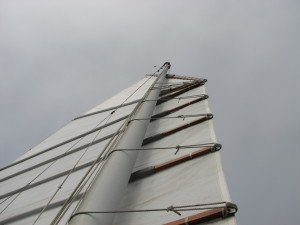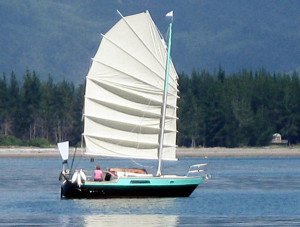The sad fact is that internet forums tend to fill up with so called experts who have strong opinions on any topic. If you wish to stray a bit off the mainstream you have to learn to just ignore these people, and in a lot of cases, ignore forums altogether. This is because if you’re just starting out with an idea, and you’re not fully convinced, you will soon lose faith in what felt like a great idea to start with. Naysayers are gonna naysay. One example is the junk rig. There was a thread about junk rigs on the boatdesign.net forums… well actually, there has been so many over the years, and they’re usually filled with comments from people who don’t really know what they’re talking about.
The chinese lugsail, a.k.a. fully battened balanced lug sail, a.k.a. junk rig (pictured above), is in a lot of ways superior to the commonly accepted standard, the Bermuda rig (BM) a.k.a. Marconi. Yes, it’s true that you’ll be able to point a bit higher with a bermuda rig but the advantages pretty much stop there. And yes, in the picture above the sail does not have any camber in it, neither by flexible or hinged battens, nor by camber sewed in the panels. Some people still build these kinds of sails and they don’t perform nearly as well as their cambered counterparts, but they’re extremely easy and fast to build and perform well enough for a lot of people. This is usually what those arguing against the junk rig have going for them. They are completely ignorant of the advances made in the last 20-30 years.
If you have no idea what a junk rig is, please read this introduction by Arne Kverneland.
Some disadvantages of the bermuda rig
In light airs you will have flogging sails. Off the wind the sails often blanket each other. So you often want to pole out the headsail while running. Which is both a hassle and can be dangerous. And because it’s such a pain to reef bermuda rigs they are usually undercanvassed, which means when running off the wind people want to deal with spinnakers, which are both very hard to handle and dangerous. All this is of course fine for racing, but when cruising you really want to have an enjoyable easy-to-handle rig. The junk rig is pretty close to the best choice there is in this regard.
Advantages of the bermuda rig
As mentioned before, it can point higher. The only other thing I can think about is that it has more options to trim the sail to fit different wind conditions. On the other hand it’s also something that you have to do, so I wouldn’t necessarily call it an advantage.
A low stress, low-tech rig
Because of the low stresses it can be built using cheap low-tech materials. The mast is unstayed, which puts a lot less stress on the hull, and it doesn’t require stays and shrouds that in themselves put strain on the hull, but also pose a risk factor in that if one piece fails, the whole rig comes down. The junk rig has its sail area spread over 6-9 panels between the battens, which puts a lot less strain on the canvas itself, compared to the bermuda (or gaff, or lug, or most other rigs for that matter), so you have a wide selection of cheap fabrics to choose from. A lot of people build junk rig sails from polytarp, although the UV resistance isn’t the best. But it can be done and you can build a 30-40 sqm sail for less than $100.
Low sheeting loads
The junk rig sheet is multipart, attached to a number of points in the sail, which makes the stress on each sheeting point much lower. The sail is also partly balanced, because of a part of it being in front of the mast, so the sheeting loads in general are much lower. In fact, it’s possible to sail upwind without any sheets at all!
Windage and weight
Because there are no stays and shrouds there is also less windage in the rig. The junk rig does have a higher center of gravity because of the weight in the mast and battens, but this is also for the most part a good thing, since it makes the boat roll in a much more pleasant slow way. Modern sailboats usually have fin keels with most of the ballast way down (for performance) and this also contributes to them having a jerky movement.
Reefing and handling
Reefing with a junk rig couldn’t be easier. You let go of the 1-2 trimming lines you have (depending on the design), let go off the halyard until the sail has come down as much as you want to. Then you just fasten the halyard and trim the sail. This can be done in under 10 seconds, right from the cockpit. I don’t know why cruising sailors would want to do more than that when it’s not necessary. Handling in general is also much easier. It’s lovely to sail into a wharf, and whereas you can spill the wind from the sails using a bermuda rig, you can often not do it in tight quarters. A headsail on a roller is the closest thing but the roller in it self is also a disadvantage, mainly because a) it causes windage while anchoring, b) it’s prone to fail and c) it makes the shape of the reefed sail area unoptimal. With the junk rig you just release the halyard and the sail comes all way down, regardless of the wind angle!
You can put on more sail area on a junk rig compared to a bermuda rig, because it’s so easy to reef. And you don’t have any extra sails taking up room down below.
Aerodynamics
C.A. Marchaj proved using aerodynamic tests that a square sail is much better off the wind than a triangular one and a normal junk rig has just this. Another criticism the junk rig often gets is that the sail is offset on one side of the mast, and the airflow isn’t the same on both tacks. This is a valid argument and junk rig sailor Ketil Greve actually did a test where he showed that there was a 5 degree difference in pointing ability. But then again, when cruising you try to avoid sailing upwind as much as you can.
One could also argue that most bermuda rigs are very inefficient in that they have a huge piece of mast just in front of the sail interfering with the airflow over the sail. A round mast (like the junk rig has) would be the most neutral, but most bermuda sails are elliptic. Which would be a good thing as long as the sail is sheeted close to the centerline. But this is never the case, so in practice you have a really weird shape going on the bermuda rig as well (alternative A in the picture above). A bermuda rig would be more effective with a rotating mast (alternative B) but that would make an already high-tech rig more high-tech. No thanks. There are better alternatives. This leads me on to the evolution towards the soft wing sail.
The soft wing sail
The soft wing sail encapsulates the mast into the sail (alternative D in the picture before), between rigid battens, and thus in the eyes of the wind, there is no mast at all. Also, compared to both the junk and the bermuda rig, both of which have camber sewn into the sail, the wing sail has a thick effective leading edge, with can (depending on the design) have an assymetric foil shape, convex on one side and concave on the other. Just like an airplane wing! When you combine the wing sail with the advantages of the junk rig (easy handling and reefing) you surely have a winning concept. That’s what I’m aiming for.
There are high tech soft wing sails like the Beneteau wing, but that’s financially out of reach for most people. At least when defining most people as people like myself who don’t have the luxury of either a large retirement fund, capital from business endeavours or a large inheritance to spend. When you evolve the junk rig into a soft wing sail, you get the same low-tech specs as the junk rig, combined with the high performance associated with wings. Sounds good doesn’t it?
David Tyler
David Tyler has experimented with soft wing sails since the 80’s and has come a long way in making them a viable alternative to both the junk rig and the bermuda rig. He has also had practical experience, clocking around 40.000 nautical miles on board his soft wing sail ketch, and another 40.000 with a junk rig sloop!
I just realized that this is quickly turning into a long article so I will split it and continue with Part II later, stay tuned!
Part II is now online: Soft wing sails, an evolutionary leap towards sailing bliss – Part II









curios on what Type of Mast You got
The mast I have is a 12 meter aluminium light pole, 4 mm wall thickness, 200 mm dia at the base, 100 mm dia at the top. I bought it from a fellow JRA member, who shipped them (I bought two) from the USA.
I wonder when I wrote that the junk rig pointed 5° lower than a Bermuda rig? Today, with a well-made cambered panel junk sail, the upwind performance gap Between the Bermuda rig and the JR has nearly been closed. Btw, about the difference between the tacks, could I suggest you look up this little account on the matter:
http://goo.gl/khii3l
Cheers,
Arne Kverneland, Norway
Oh, it wasn’t you, but your post on Yahoo Groups mentioning that Ketil Greve had measured it. I remembered incorrectly.
Source: https://groups.yahoo.com/neo/groups/junkrig/conversations/messages/16064
I just corrected the article.
I humbly think the soft wing sail is the future for dinghys and cruising sail boats.
I am very interested in trying one soft wing sail corresponding to a 23m2 “standard” rigging area for a 6.3m dinghy.
I am looking for any interesting places to shop for such a soft wing.
Hi there,
I have a luff pocket wingsail with a mast of 12m hight and 150mm diameter to 3mm wall.
With 30kn of wind the mast shakes in the middle part up to 30 or 40cm. I was scared and secured them with a line to the ship, but i simply can’t imagine that it will be strong enough under sail.
Is there anybody that has experience with the measurements of wingmasts?